How to make acorn squash baby food
Roasted Acorn Squash Baby Food
byAmy Palanjian
Posted
Jump to RecipeThis post may contain affiliate links. If you shop from one of our links, we may earn a commission.
Learn the easiest way to turn fresh acorn squash into Acorn Squash Baby Food—as both a puree and a baby-led weaning finger food. This can also work as an easy side dish for the entire family, or you can easily freeze portions for future weeks.
Acorn Squash Baby Food
When fresh winter squash like acorn squash is available, it’s such an easy option to make it and share it with babies and toddlers. At the end of summer and throughout fall and winter, this hard squash is usually affordable at both the grocery store and farmer’s markets. It’s wonderful as a baby food since it has a naturally sweet, yet subtle flavor—sort of in the same realm of flavor as butternut squash.
Acorn squash is really hard to peel since it has such an interesting curved shape, but the good news here is that you don’t even have to peel it to make this recipe. And acorn squash is straight-forward to cut. Winning!
Ingredients You Need
Here’s a look at what you need to make this recipe so you can pick up the ingredients at the store.
- Acorn squash: Look for a firm, heavy acorn squash at the supermarket or farmer’s market. They are typically dark green with a yellow spot where it rested on the ground.
- Olive oil: Extra-virgin olive oil is my preferred option for brushing onto the slices before roasting.
- Cinnamon, cumin, Chinese Five Spice (optional): Any of these can add flavor to the slices. You can also leave them plain to enjoy the pure winter squash flavor.
Step-by-Step Instructions
Here’s a look at how to make this easy baby food recipe. Scroll down to the end of the post for the full details and timing.
- Wash and dry the acorn squash. Slice the stem and base off.
- Cut in half and scoop out the seeds.
- Slice.
- Arrange on a baking sheet. Drizzle with oil and sprinkle with any optional seasonings.
 Bake until fork tender.
Bake until fork tender.
Acorn Squash Puree
To turn the roasted squash into a puree, scoop the flesh off of the skin and add it to a blender. Blend, adding no-salt-added broth, breastmilk, formula or 1 tablespoon water, at a time until you have a smooth puree.
Baby-Led Weaning Acorn Squash
To serve the slices baby-led weaning style, serve one slice at a time. (The skin helps hold the squash together, and baby will typically spit it out. Demonstrate which side to eat the squash slice from.)
How to Store
Store puree in storage containers in the fridge for up to 5 days or freeze in ice cube trays and transfer frozen cubes to a freezer bag for up to 6 months. Thaw 1-2 cubes in a container overnight in the fridge. Store slices in storage container in the fridge for up to a week.
Best Tips for Success
- Add a sprinkle of one of the optional spices for more flavor.
- Combine with an equal amount of one of the following purees at a time to make an Acorn Squash Baby Food Combinations: Avocado Puree, Apple Puree, Pear Puree, Banana Puree, Spinach Puree, Green Bean Puree, Beets Baby Food, and Zucchini Baby Food.
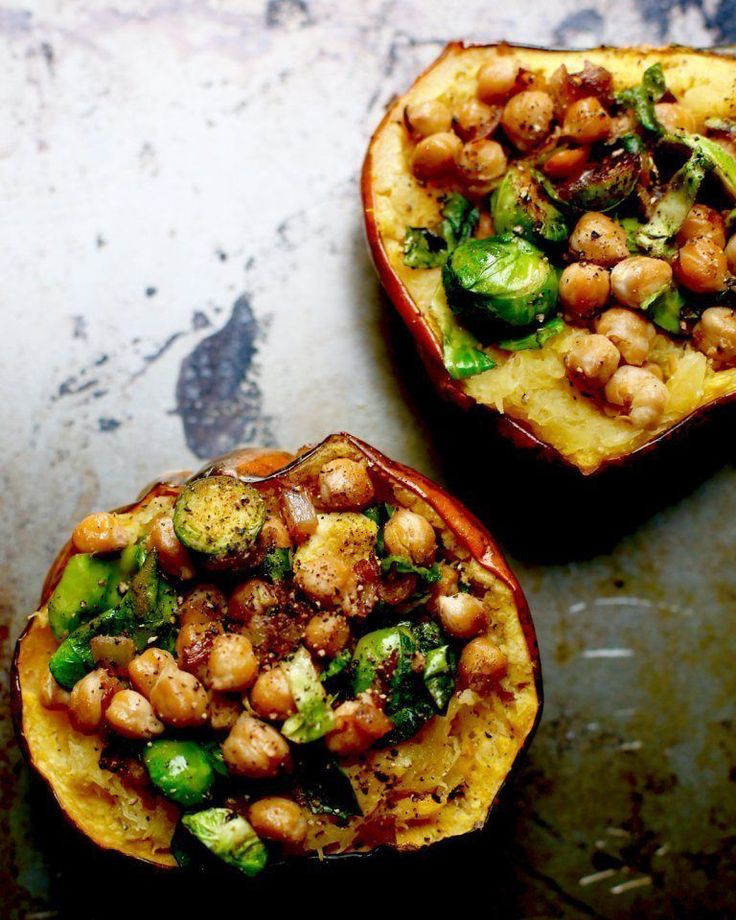
- Enjoy the roasted slices as a side dish for family dinner. You may want to add a little salt for yourself.
- Roasted skin of acorn squash is edible, as it softens a lot when cooking. You can also just discard it.
Related Recipes
I’d love to hear your feedback on this post, so please rate and comment below!
Prep Time 10 minutes
Cook Time 18 minutes
Total Time 28 minutes
Author Amy Palanjian
Cuisine American
Course Baby Food
Calories 74kcal
Servings 4 -6
- ▢ 1 acorn squash
- ▢ 1 tablespoon olive oil
- ▢ ½ teaspoon cinnamon, cumin, Chinese Five Spice (optional)
Preheat the oven to 400 degrees F and line a baking sheet pan with parchment paper or foil.
Wash and dry the acorn squash. Slice the stem and the base off of the squash. Cut in half and scoop out the seeds with a spoon.
Slice into 1-inch crescent-moon-shape slices.
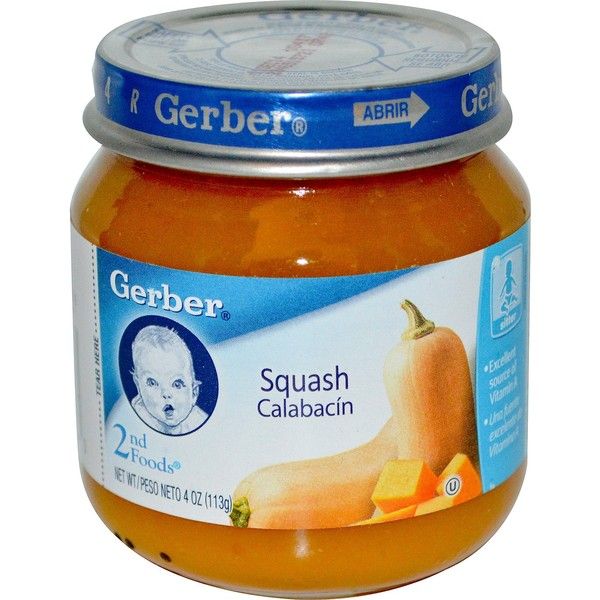 Arrange in a layer on the prepared baking sheet. Drizzle the olive oil overtop and rub to coat, turning each piece over so both sides are coated in oil.
Arrange in a layer on the prepared baking sheet. Drizzle the olive oil overtop and rub to coat, turning each piece over so both sides are coated in oil.Sprinkle with any optional seasonings.
Bake for 18-20 minutes, or until the pieces are tender when poked with a fork.
To serve baby-led weaning style: Serve one slice at a time. (The skin helps hold the squash together and baby will typically spit it out. Demonstrate which side to eat the squash slice from.)
To make a puree: Scoop the flesh off of the skin and add it to a blender. Blend, adding 1 tablespoon water, no-salt-added broth, breastmilk, or formula at a time until you have a smooth puree.
Vitamix Blender
Storage Containers
Reusable Pouch
Store puree in storage containers in the fridge for up to 5 days or freeze in ice cube trays and transfer frozen cubes to a freezer bag for up to 6 months. Thaw 1-2 cubes in a container overnight in the fridge. Store slices in storage container in the fridge for up to a week.
Thaw 1-2 cubes in a container overnight in the fridge. Store slices in storage container in the fridge for up to a week.
Add a sprinkle of one of the optional spices for more flavor.
Combine with an equal amount of one of the following purees at a time to make an Acorn Squash Baby Food Combinations: Avocado Puree, Apple Puree, Pear Puree, Banana Puree, Spinach Puree. and Zucchini Baby Food.
Enjoy the roasted slices as a side dish for family dinner. You may want to add a little salt for yourself.
Roasted skin of acorn squash is edible, as it softens a lot when cooking. You can also just discard it.
Serving: 0.25cup (or 1 slice), Calories: 74kcal, Carbohydrates: 11g, Protein: 1g, Fat: 4g, Saturated Fat: 1g, Polyunsaturated Fat: 0.4g, Monounsaturated Fat: 3g, Sodium: 3mg, Potassium: 374mg, Fiber: 2g, Vitamin A: 395IU, Vitamin C: 12mg, Calcium: 36mg, Iron: 1mg
Tried this recipe?Rate in the comments and tag @yummytoddlerfood on IG!
Related Posts
Related Products
Happy Family Meals (Meal Plans)
Buy Now
Happy Family Meals (Vol 2)
Buy Now
Yummy Toddler Snacks
Buy Now
Yummy Baby Food
Buy Now
Share it with the world
FacebookTweetPinFiled Under
Acorn Squash Puree Recipe - Recipes Worth Repeating
Making acorn squash puree is low maintenance and easy! With only 2 ingredients, roasting acorn squash and then pureeing is great to use in a variety of other recipes.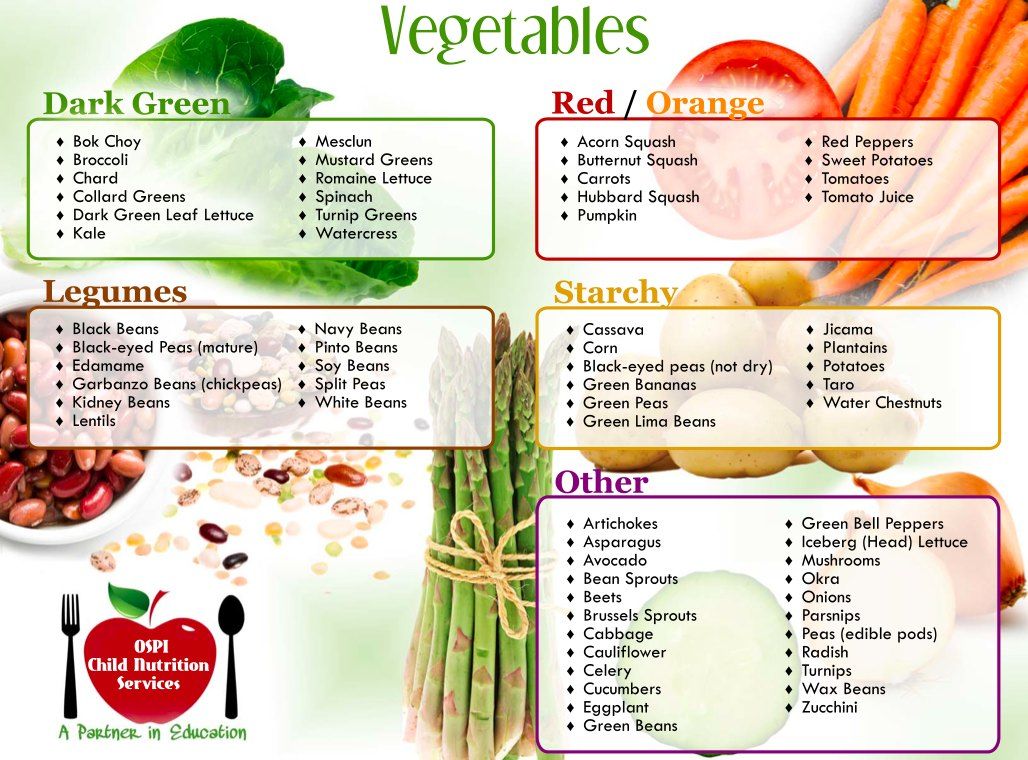 It's the perfect puree for making muffins, baby food, pancakes, and so much more! You can even enjoy it on its own!
It's the perfect puree for making muffins, baby food, pancakes, and so much more! You can even enjoy it on its own!
- ✔️ Quick Recipe Overview
- ℹ️ Why This Recipe Works
- 🛒 Ingredients You'll Need
- Types of Squash
- 👩🍳 Roasting Works Best
- 🔪 How To Cut Acorn Squash
- 📋 Step-By-Step Recipe Instructions
- How To Puree
- 👶 Acorn Squash Baby Food
- 🙋 Frequently Asked Questions
- 💭 Expert Tips
- 🍽️ More Squash Recipes
- Acorn Squash Puree
Butternut squash and pumpkin puree can easily be found at just about any grocery store, but it's extremely rare to find acorn squash puree. And I have no idea why! It's smooth, velvety, and full of flavor. And it's extremely healthy. Since you can't typically buy it at the store like you can other types of purees, there is a huge benefit to learning how to make it at home. Not only is it healthier than store bought, it's really simple to make.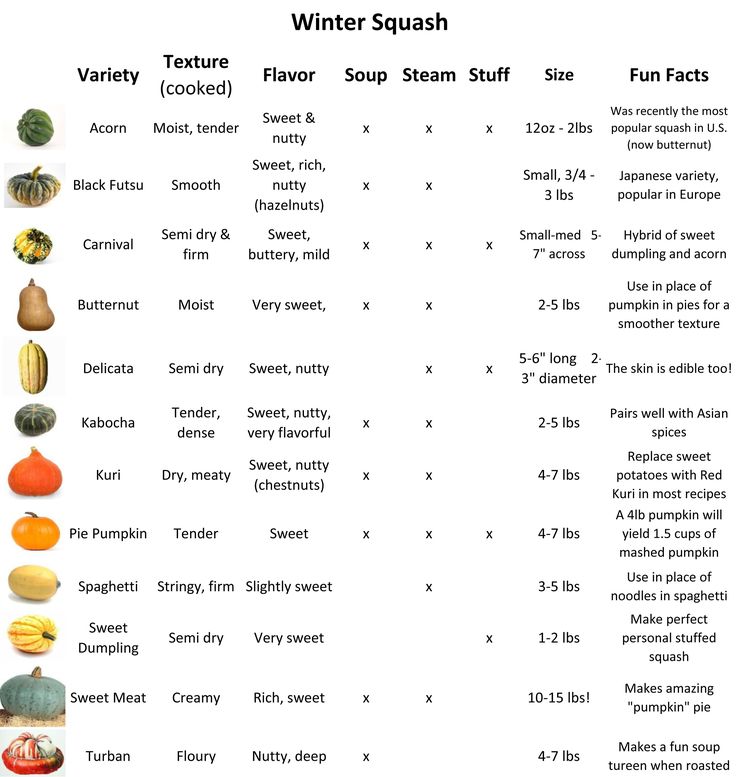
Acorn squash is one of those vegetables that doesn't get a lot of attention. Butternut and spaghetti squash are the popular ones, but acorn is my favorite winter vegetable. Vibrant, colorful, and full of nutrition, it can be prepared and used in many ways. When added to these acorn squash muffins, not only does it add a warm and delicious flavor, but the puree adds an incredible amount of moisture! A moisture level I typically don't find in muffins.
🛒 Ingredients You'll Need
To make this recipe, all you need is an acorn squash and olive oil. When olive oil is basted onto the flesh, it helps trap in the natural water content which produces a thicker puree. If you're making this for a baby and want to omit the olive oil, baste on a small amount of water to help maintain the moisture level.
Types of Squash
The most common types of squash used for cooking include butternut, yellow, hubbard, spaghetti, zucchini, pumpkin, and acorn. (Yes, pumpkin is technically a squash.) While there are some similarities between these different types, they are all a bit quite different. Summer squash, like yellow and zucchini, tend to have a soft outer shell. Winter squash has a harder shell and can be found in the fall and winter months. For instance, hubbard is a winter squash and is great for making soups, like in this delicious blue hubbard squash soup.
(Yes, pumpkin is technically a squash.) While there are some similarities between these different types, they are all a bit quite different. Summer squash, like yellow and zucchini, tend to have a soft outer shell. Winter squash has a harder shell and can be found in the fall and winter months. For instance, hubbard is a winter squash and is great for making soups, like in this delicious blue hubbard squash soup.
Spaghetti squash is often used as a substitute for pasta. It has a mild flavor and is the perfect choice when making dishes like this spaghetti squash with goat cheese. After it has been roasted in the oven, it's easy to use a fork and shred. Add some marinara or pesto sauce and you've got a low carb meal that is perfect for any lunch or dinner!
While butternut squash is popular during the fall season, it's also used a lot in summer recipes like salads and these smoked chile rellenos. Butternut squash is a bit sweeter than the other varieties and has a slightly nutty taste.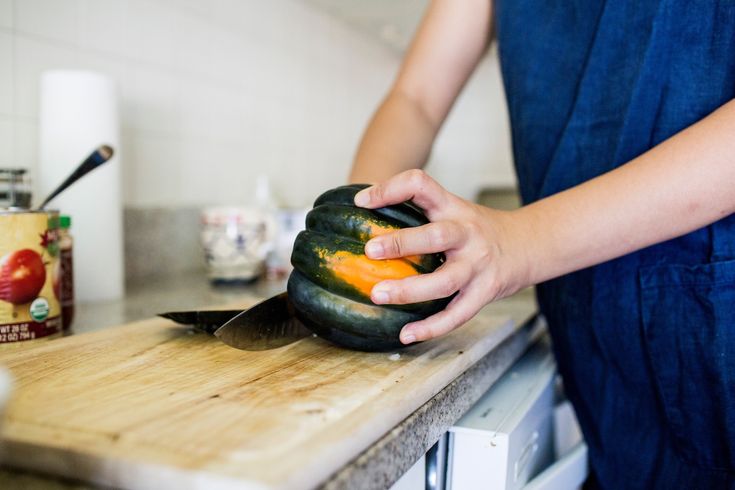 It works extremely well as the base of a soup, like in this spiced butternut squash soup. As for yellow squash, it's great when pan fried and is a great addition to these oven roasted peppers and mushrooms.
It works extremely well as the base of a soup, like in this spiced butternut squash soup. As for yellow squash, it's great when pan fried and is a great addition to these oven roasted peppers and mushrooms.
Acorn squash is considered both a summer and winter squash and is extremely healthy. It's high in fiber and does a great job absorbing nutrients from foods it's paired or mixed with. Mostly commonly, it's roasted, steamed, and baked. It tends to be a bit more stringy and fibrous than other types. It's also great for stuffing. The calories are slightly higher than other types. For example, one cup of baked, cubed butternut squash contains 82 calories, where acorn contains 115 calories for one cup.
👩🍳 Roasting Works Best
For best results, roast acorn squash in the oven when making puree. I've tried steaming, boiling, and microwaving it and roasting provides the richest and most savory flavor. When it's roasted, the texture becomes velvety smooth and the orange color is bright, rich, and vibrant.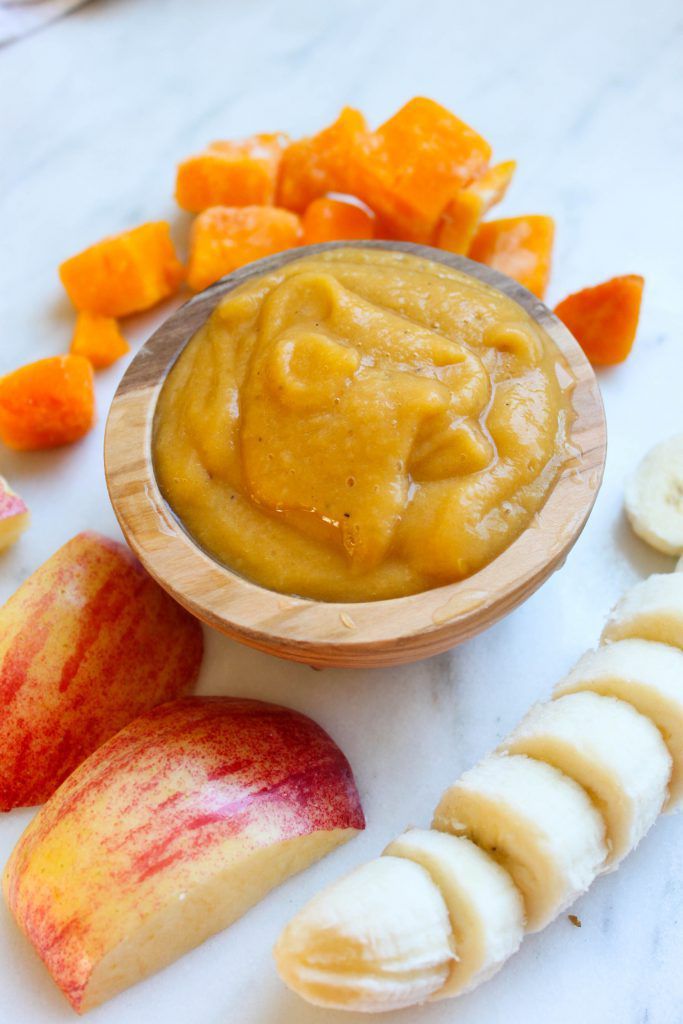 It's full of robust flavor.
It's full of robust flavor.
When boiled, the consistency was watery and tasted like the nutrients had been stripped out during the boiling process. Steaming removed a lot of flavor and the texture was too soft. When I cooked it in the microwave, the consistency was ok, but it felt a bit too dehydrated. Roasting acorn squash is hands down the way to go when making puree.
🔪 How To Cut Acorn Squash
It's important to cut the squash before roasting it in the oven. It has a hard outer shell that can be difficult to cut through. When cutting vegetables or even melons with hard outer shells, it's important to use a cutting board and a large sharp knife. A heavy and sharp chef knife works well.
Start by cutting off the stem. With rounded fingers holding the vegetable firmly in place, press the knife into the shell and use a steady sawing motion to remove the stem. Removing the stem will leave a flat surface that is well balanced for cutting it in half. From there, lay the flat side (where you removed the stem) down on a cutting board. Insert the knife, ensuring the tip of the blade is pointing downward toward the cutting board. Use a firm downward motion to cut it in half.
From there, lay the flat side (where you removed the stem) down on a cutting board. Insert the knife, ensuring the tip of the blade is pointing downward toward the cutting board. Use a firm downward motion to cut it in half.
📋 Step-By-Step Recipe Instructions
Start by cutting the squash lengthwise on a cutting board. Take a large metal spoon and scoop out all the seeds and strings.
Dip a basting brush in olive oil and baste it over the flesh of the vegetable. This helps keep the moisture in and keeps it from drying out when roasting in the oven.
Preheat the oven to 350°F. Since we're making puree, place it flesh side down on a baking sheet lined with aluminum foil or parchment paper. The hard shell should be facing up when roasting acorn squash in the oven.
Bake for 45 minutes. When done, remove the baking sheet from the oven and allow it to cool for about 10 minutes. Using a heavy spoon, remove the roasted squash and place it into a food processor or blender.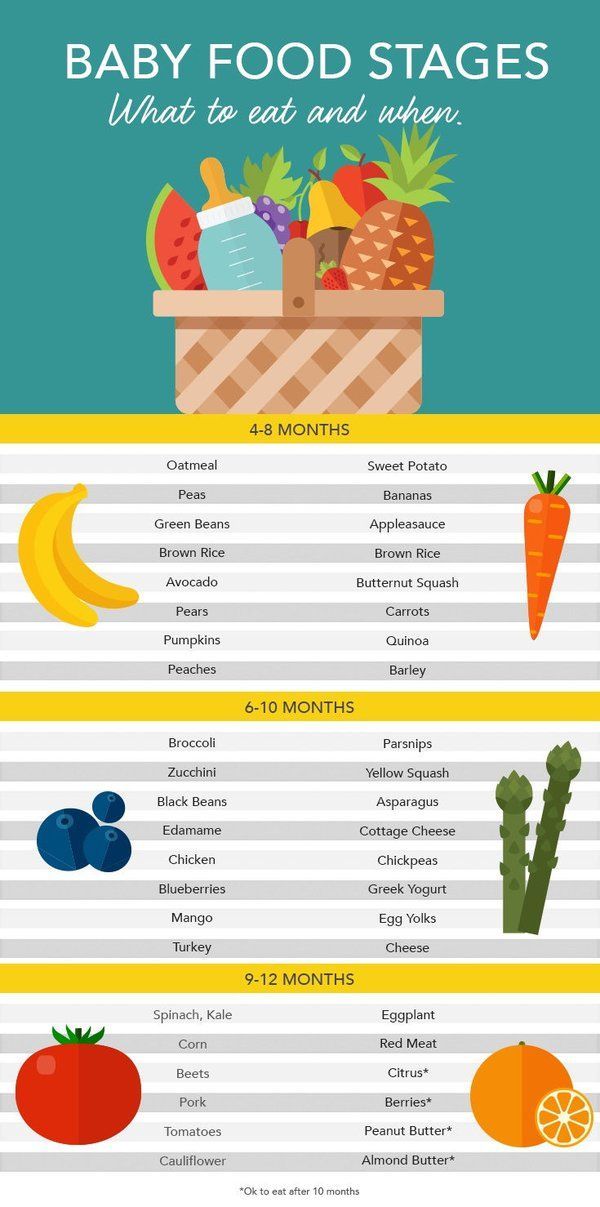 The shell should not be used to make the puree.
The shell should not be used to make the puree.
To get a super smooth consistency, turn on the food processor or blender and puree. There is no need to add additional olive oil, water, or any other liquid.
Once the mixture is smooth and slightly thick, put the puree into a bowl and it's ready for use!
How To Puree
Pureeing is a cooking technique that mashes different types of food into a smooth and slightly thick paste like substance. A blender or food processor is typically used to puree foods like vegetables, fruits, and even beans. To puree acorn squash, place the lid on the blender or food processor and puree until the substance is smooth. To make it more of a mashed consistency, skip the food processor and use a hand held masher. An immersion blender can also be used. I've even had a lot of success using a standing and electric mixer! Or, using a fork to mash can also be highly effective.
👶 Acorn Squash Baby Food
When making your own baby food at home, it's important to keep the ingredients simple and basic. If you're using this recipe to make homemade baby food, eliminate basting on the olive oil. Instead, baste on a small amount of water. Roasting it flesh down with a small amount of water helps trap in the natural moisture so no other liquids need to be added when pureeing. This method produces the best texture of puree. Not too thick and not too watery. And it's perfectly tasty and nutritious for your little one!
If you're using this recipe to make homemade baby food, eliminate basting on the olive oil. Instead, baste on a small amount of water. Roasting it flesh down with a small amount of water helps trap in the natural moisture so no other liquids need to be added when pureeing. This method produces the best texture of puree. Not too thick and not too watery. And it's perfectly tasty and nutritious for your little one!
🙋 Frequently Asked Questions
How long is puree squash good for?
Stored in the refrigerator in a container with a lid, it will last for 3-4 days. It will last in the freezer for up to 3 months.
Do you need to peel acorn squash before roasting?
No. When roasting it flesh down, the shell helps trap in the moisture which contributes to the velvety smooth texture when pureed.
Is acorn squash healthy?
Yes! Not only is it naturally high in fiber and helps aid in digestion, but it's also full of antioxidants.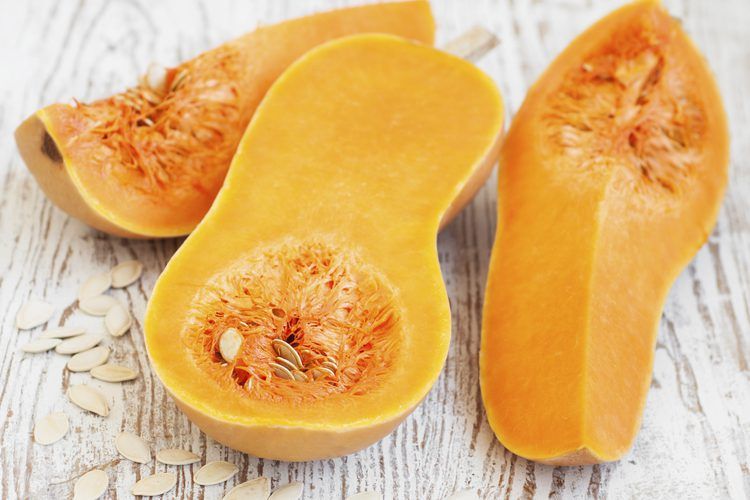 It also contains a lot of vitamin C and beta-carotene which help support eye health.
It also contains a lot of vitamin C and beta-carotene which help support eye health.
💭 Expert Tips
- Substitute the olive oil for any healthy oil such as extra-virgin olive oil or grapeseed oil.
- While you don't need to add any additional liquid, you can add some if necessary. I've found that if you roast it for a full 45 minutes, it turns out incredibly soft and there is no need to add a liquid, butter, or cream to change the consistency.
- Butternut or hubbard both work well as a substitute.
- Did you know that you can eat the skin on acorn squash? Yes, you sure can and it's surprisingly tasty!
- Freezing this puree is easy. Whenever I'm roasting any type of vegetable to make puree, I alway make extra so I can freeze it for later. To freeze, allow the puree to completely cool and then place it in a freezer safe container. Write the date on a label so you know when it was made. Place it in the freezer for up to 3 months.
🍽️ More Squash Recipes
I love spaghetti but it's so heavy and full of carbs. For a nice alternative, I use a spaghetti squash and pile on my spaghetti sauce. I also really enjoy it with this homemade basil pesto. Squash can also be added to a variety of different soups. I enjoy adding yellow squash to this poor man's soup and to this chicken vegetable soup recipe.
For a nice alternative, I use a spaghetti squash and pile on my spaghetti sauce. I also really enjoy it with this homemade basil pesto. Squash can also be added to a variety of different soups. I enjoy adding yellow squash to this poor man's soup and to this chicken vegetable soup recipe.
Follow Recipes Worth Repeating for more amazing recipes!
- ▢ 1 acorn squash
- ▢ 1 tablespoon olive oil
Preheat the oven to 350°F.
Start by cutting the squash lengthwise on a cutting board. Take a spoon and dig out all the seeds and strings. Discard or save the seeds for roasting later on.
Dip a basting brush into the olive oil and evenly baste over the flesh.
Place each piece flesh down on a baking sheet lined with aluminum foil or parchment paper. You want the hard shell to be face up when roasting.
Roast in the oven for 45 minutes. When done, remove the baking sheet and all to cool for about 10 minutes.
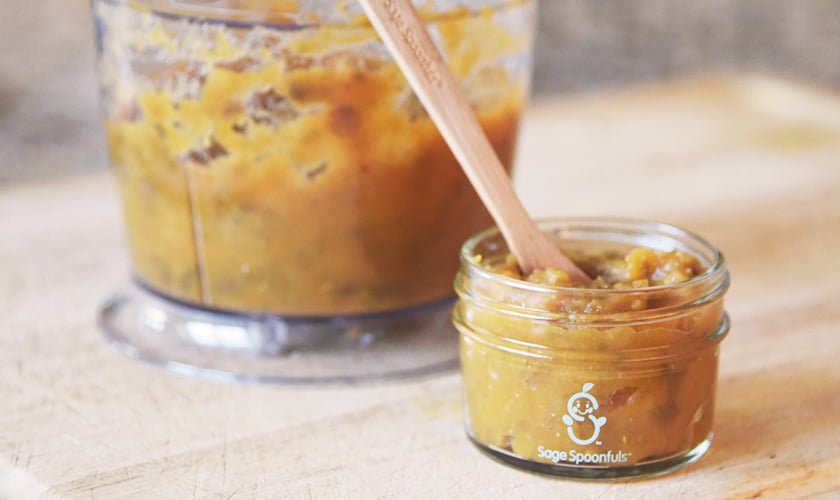
Using a heavy spoon, remove the roasted squash and place into a food processor or blender. Note: It should be extremely tender and easy to spoon out.
Turn on the food processor or blender and puree for 20-30 seconds.
Use immediately or store in the refrigerator until ready for use.
- Substitute the olive oil for any healthy oil such as extra-virgin olive oil or grapeseed oil.
- While you don't need to add any additional liquid, you can add some if necessary. I've found that if you roast it for a full 45 minutes, it turns out incredibly soft and there is no need to add a liquid, butter, or cream to change the consistency.
- You can substitute either butternut or hubbard.
- If you're using this recipe to make homemade baby food, eliminate basting on the olive oil.
 Instead, baste on a small amount of water.
Instead, baste on a small amount of water. - Did you know that you can eat the skin? Yes, you sure can and it's surprisingly tasty!
- Freezing this puree is easy. Whenever I'm roasting any type of vegetable to make puree, I alway make extra so I can freeze it for later. To freeze, allow the puree to completely cool and then place it in a freezer safe container. Write the date on a label so you know when it was made. Place it in the freezer for up to 3 months.
Calories: 49kcal | Carbohydrates: 7g | Protein: 1g | Fat: 2g | Saturated Fat: 1g | Polyunsaturated Fat: 1g | Monounsaturated Fat: 2g | Sodium: 2mg | Potassium: 249mg | Fiber: 1g | Vitamin A: 264IU | Vitamin C: 8mg | Calcium: 24mg | Iron: 1mg
Tried this Recipe? Pin it for Later!Mention @RecipesWorthRep or tag #RecipesWorthRepeating!
Pumpkin puree for babies, recipe - step by step recipe with photo. The author of the recipe Alexander is the director of Cookpad.
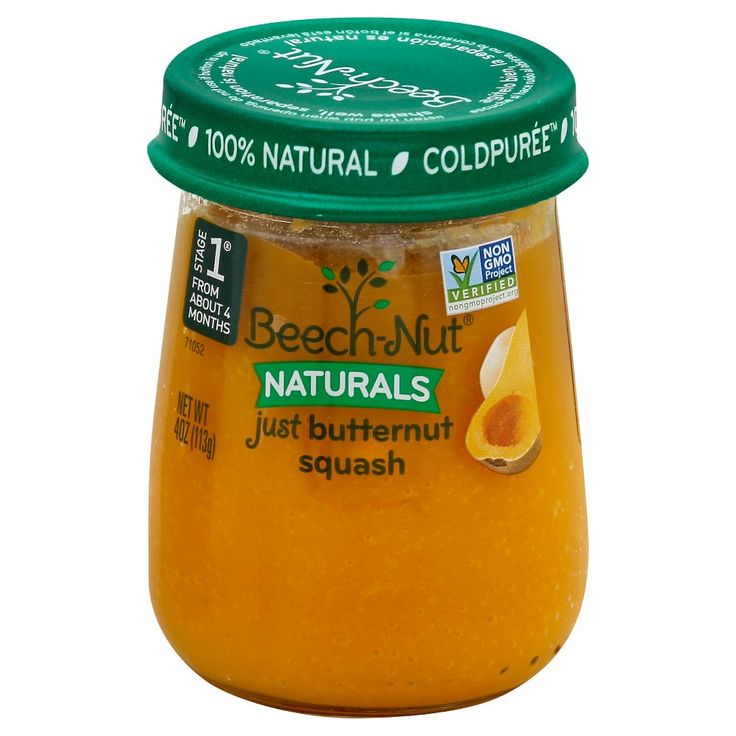
Alexander - director of Cookpad @kislenko
Moscow, Russia
Today we will tell you how to make pumpkin puree for babies. The recipe is useful to all mothers of babies from four months.
By the fifth month of life, the child does not have enough nutrients from mother's milk, and vegetable and fruit purees begin to be introduced into baby food. nine0003
Pumpkin puree for babies is suitable for a baby's first introduction to vegetables. It is not only tasty, but also helps to adjust the work of digestion, gives the baby material for growth and proper development. Pumpkin helps to form bones and muscles, contributes to the health of the eyes, nerves, stomach, intestines, heart, prevents anemia, improves children's sleep, strengthens the immune system.
Pumpkin puree is introduced into the children's diet after squash puree and cauliflower puree, which do not cause allergies.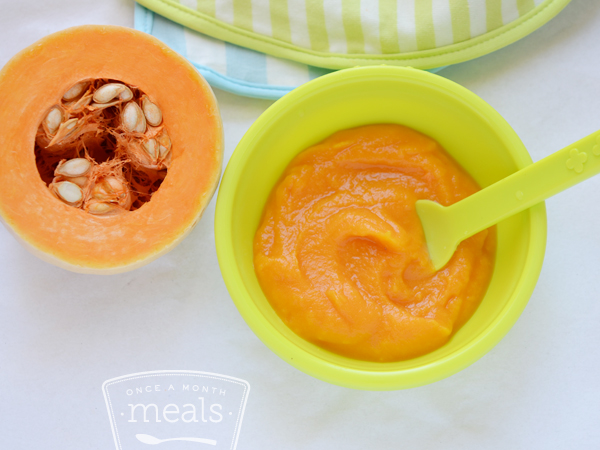 The baby should like the taste, color and aroma of pumpkin, because they are brighter than what he has already tried. nine0003
The baby should like the taste, color and aroma of pumpkin, because they are brighter than what he has already tried. nine0003
It is recommended to give pumpkin puree to a child at least three times a week (unless he has an allergy, which, to be fair, is very rare for pumpkin). At first, limit yourself to half a teaspoon, as the digestive system must get used to the new type of food.
Pumpkin puree can be combined with other vegetables or fruits: carrots, potatoes, apples, bananas, etc. Sugar can be added at your discretion, but pediatricians do not recommend doing this for at least a year. Better add sweet fruit. Pumpkin should be chosen young, weighing up to 3-5 kg. It is sweeter and juicier and easier to peel. nine0003 More
popover#show mouseleave->popover#hide" >
Save this recipe for later.
Edit Recipe Add cooksnapAdd cooksnap
ShareShare
Ingredients
-
100 g pumpkin
How to cook
See how to cook this dishEmotions
Karina Putchenkova responded
Cooksnaps
Author
Alexander - director of Cookpad @kislenko
